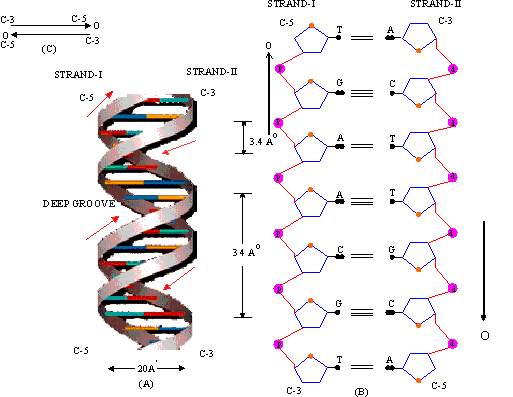|
PinkMonkey Online Study Guide-Biology
Similarly, when many nucleotides are linked with each
other in a linear fashion, the resulting chain, is referred to as a polynucleotide
(polymer, or). For example, each strand of DNA molecule has many deoxyribonucleotides
linked in a chain-like arrangement. Therefore, it is described as polynucleotide
strand and DNA molecule as polynucleotide molecule.
In the DNA polynucleotide strands, the nucleotides are joined with each other by ‘phosphodiester linkages’ (Figure. 8.3).
In a phosphodiester linkage, the phosphate group present at the C-5 of the sugar of one nucleotide gets attached to the C-3 of the sugar of the next nucleotide in the chain.
(b) The Watson-Crick model of the DNA double helix
: The most widely accepted model for the structure of DNA molecule
(Figure 8.4) was proposed by Watson and Crick in 1953 (who won the
Nobel Prize for Medicine in 1962). According to their model, the
DNA has the following structural characteristics.
i. Molecule : The DNA molecule is a double
helix (Fig. 8.4A). The molecule is formed by two antiparallel
polynucleotide strands which are spirally coiled round each
other in a right-handed helix. The two strands are held together by hydrogen
bonds. The double stranded helical molecule has alternate major
(or deep) and minor grooves.
 Click here to enlarge
Click here to enlarge
Figure 8.4. Structure of DNA (Watson and Crick model)
(A) DNA double helix. (B) Detailed structure of the two strands. (C) C-5
and C-3 ends and antiparallel nature of strands (diagrammatic)
ii. Structure of each strand (8.4 B) : Each strand
is a long polynucleotide of deoxyribonucleotides. The backbone of the
strand is formed by alternately arranged deoxyribose sugar and phosphate
molecules which are joined by the phosphodiester linkages. Each
sugar in the strand has one base horizontally attached to it at carbon-1.
It can be any one of the four: A,#T,#G or C. These four N-bases can occur
in any possible sequence along the length of a strand.
iii. Complementary nature of the strands : The
two strands are complementary to each other with regards to the arrangement
of the bases in the two strands. For example, where adenine (a purine)
occurs in one strand, thymine (a pyrimidine) is present in the corresponding
position in the opposite strand and vice versa. Similarly, wherever guanine
(a purine) is present in one strand, the other strand has cytosine (a
pyrimidine) opposite to it and vice versa. Thus, in the double helix,
purines and pyrimidines exist in base pairs, i.e., (A and T) and (G and
C). As a result, if the base sequence of one strand of DNA is known, the
base sequence of its complementary strand can be easily deduced.
|